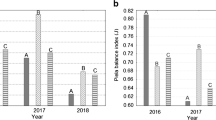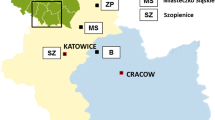Abstract
Several management practices that are employed in Montados are known to affect the establishment and maintenance of Basidiomycota communities immediately after disturbances have occurred, contributing to their development or, conversely, decreasing their diversity. In this study we aim to evaluate the effects of the most common understory and soil-management practices on the diversity of the epigeous Basidiomycota a long time after disturbances have taken place. The study was conducted in a Montado (cork and holm-oak ecosystem) area in Southern Portugal (Alentejo). In 1998, four experimental treatments—control (C), mulching (Mu), mowing (Mo) and ploughing (P)—with three replicates each were carried out: C—untreated/untouched; Mu—cutting of shrubs followed by deposition of plant residues on soil surfaces; Mo—cutting of shrubs followed by biomass removal and soil tilling; P—cutting of shrubs followed by the incorporation of plant biomass into the soil through tillage. Macrofungal surveys were conducted fortnightly in the experimental plots between Autumn 2007 and Spring 2012. Significant differences in total and mycorrhizal richness were found between plots, with higher values being found for non-tilled plots and lower values for tilled plots. No significant differences were found in saprotrophic richness between treatments. Regarding the composition of taxa, Boletus and Russula were the main taxonomic groups affected by experimental treatments. Our results showed that soil tillage can result in a decrease in mycorrhizal taxa even a long time after disturbances have taken place.


Similar content being viewed by others
References
Azul AM, Castro P, Sousa JP, Freitas H (2009) Diversity and fruiting patterns of ectomycorrhizal and saprobic fungi as indicators of land-use severity in managed woodlands dominated by Quercus sube—a case study from Southern Portugal. Can J For Res 39(12):2404–2417
Azul AM, Sousa JP, Aeger R, Martín MP, Freitas H (2010) Land use practices and ectomycorrhizal fungal communities from oak woodlands dominated by Quercus suber L. considering drought scenarios. Mycorrhiza 20(2):73–88
Azul AM, Mendes SM, Sousa JP, Freitas H (2011) Fungal fruitbodies and soil macrofauna as indicators of land use practices on soil biodiversity in montado. Agrofor Syst 82:121–138
Baker JM, Ochsner TE, Venterea RT, Griffis TJ (2007) Tillage and soil carbon sequestration—what do we really know? Agric Ecosyst Environ 118:1–5. doi:10.1016/j.agee.2006.05.014
Baptista P, Martins A, Lino-Neto T, Tavares RM (2005) Effect of soil tillage on diversity and abundance of macrofungi associated with chestnut tree in the Northeast of Portugal. Acta Hortic 693:685–690
Barrico L, Rodríguez-Echeverría S, Freitas H (2010) Diversity of soil basidiomycete communities associated with Quercus suber L. Port montados. Eur J Soil Biol 46(5):280–287
Breitenbach J, Kränzlin F (1984) Champignons de suisse, tome 1: les ascomycètes. Mycologia, Lucerne
Breitenbach J, Kränzlin F (1986) Champignons de suisse, tome 2: champignons sans lames. Mycologia, Lucerne
Breitenbach J, Kränzlin F (1991) Champignons de suisse, tome 3: bolets et champignons à lames 1ère partie. Mycologia, Lucerne
Breitenbach J, Kränzlin F (1995) Champignons de suisse, tome 4: champignons à lames 2ème partie. Mycologia, Lucerne
Breitenbach J, Kränzlin F (2000) Champignons de suisse, tome 5: champignons à lames 3ème partie. Mycologia, Lucerne
Brunner I (2001) Ectomycorrhizas: their role in forest ecosystems under the impact of acidifying pollutants. Perspect Plant Ecol 4(1):13–27
Calado M, Louro R, Santos-Silva C (2009) Influence of different management practices in the macrofungal communities of a cork oak stand after an extended drought period, in Southern Portugal. B Soc Micol Madrid 33:237–253
Calvo L, Tárrega R, Luís E, Valbuena L, Marcos E (2005) Recovery after experimental cutting and burning in three shrub communities. Plant Ecol 180:175–185
Canteiro C, Pinto-Cruz C, Paula Simões M, Gazarini L (2011) Conservation of Mediterranean oak woodlands: understory dynamics under different shrub management. Agrofor Syst 82:161–171
Comandini O, Contu M, Rinaldi AC (2006) An overview of Cistus ectomycorrhizal fungi. Mycorrhiza 16(6):381–395. doi:10.1007/s00572-006-0047-8
Egerton-Warburton LM, Querejeta JI, Allen MF (2007) Common mycorrhizal networks provide a potential pathway for the transfer of hydraulically lifted water between plants. J Exp Bot 58(6):1473–1483
Frade B, Alfonso A (2003) Atlas fotográfico de los hongos de la Península Ibérica. Celarayn, León
Guidot A, Debaud J-C, Effosse A, Marmeisse R (2003) Below-ground distribution and persistence of an ectomycorrhizal fungus. New Phytol 161:539–547
Hartnett DC, Wilson GT (2002) The role of mycorrhizas in plant community structure and dynamics: lessons from grasslands. Plant Soil 244:319–331
Hernández-Rodríguez M, Oria-de-Rueda JA, Martín-Pinto P (2013) Post-fire fungal succession in a Mediterranean ecosystem dominated by Cistus ladanifer L. For Ecol Manag 289:48–57
INMG (1991) O Clima de portugal. normais climatológicas da região de Alentejo e Algarve, correspondentes a 1951–1980, vol 4. Fasc XLIX, Lisboa
Kennedy PG, Izzo AD, Bruns TD (2003) There is high potential for the formation of common mycorrhizal networks between understorey and canopy trees in a mixed evergreen forest. J Ecol 91:1071–1080
Kränzlin F (2005) Champignons de suisse, tome 6: russulaceae. Mycologia, Lucerne
Laganà A, Loppi S, De Dominicis V (1999) Relationship between environmental factors and the proportions of fungal trophic groups in forest ecosystems of the central Mediterranean area. For Ecol Manag 124:145–151
Louro R, Calado M, Pinto B, Santos-Silva C (2009) Epigeous macrofungi of the parque de natureza de noudar in Alentejo (Portugal). Mycotaxon 107:49–52
Martín-Pinto P, Vaquerizo H, Peñalver F, Olaizola J, Oria-de-Rueda JA (2006) Early effects of a wildfire on the diversity and production of fungal communities in Mediterranean vegetation types dominated by Cistus ladanifer and Pinus pinaster in Spain. For Ecol Manag 225:296–305
Mendes SM, Santos J, Freitas H, Sousa JP (2011) Assessing the impact of understory vegetation cut on soil epigeic macrofauna from a cork-oak montado in South Portugal. Agrofor Syst 82(2):139–148
Moreno G, Manjon JLG, Zugaza A (1986) La guia de incafo de los hongos de la Peninsula Iberica, 2 tomos. Incafo, Madrid
O´Dell TE, Lodge DJ, Muller GM (2004) Approaches to sampling macrofungi. In: Mueller G, Bills G, Foster M (eds) Biodiversity of fungi—inventory and monitoring methods. Elsevier academic press, San diego, pp 163–168
Panagoupolos T, Andrade R, Ferreira V, Guerrero C (2012) Assessment of spatial variability of soil properties in areas under land use CHANGE due to the Alqueva dam construction. In: Panagopoulos T, Burley J, Loures L (eds) Recent researches in environmental science & landscaping. WSEAS Press, Faro, Algarve, pp 26–31
Pérez-Ramos IM, Zavala MA, Marañón T, Díaz-Villa MD, Valladares F (2008) Dynamics of understorey herbaceous plant diversity following shrub clearing of cork oak forests: a five-year study. For Ecol Manag 255:3242–3253
Pielou EC (1984) The interpretation of ecological data: a primer on classification and ordination. Wiley, New York
Pinto-Correia T (1993) Threatened landscape in Alentejo, Portugal: the montado and other agro-sylvo-pastoral systems. Landscape Urban Plan 24:43–48
Pinto-Correia T, Ribeiro N, Sá-Sousa P (2011) Introducing the montado, the cork and holm oak agroforestry system of Southern Portugal. Agrofor Syst 82(2):99–104
Plieninger T (2007) Compatibility of livestock grazing with stand regeneration in Mediterranean holm oak parklands. J Nat Conserv 15(1):1–9. doi:10.1016/j.jnc.2005.09.002
Plieninger T, Pulido FJ, Schaich H (2004) Effects of land-use and landscape structure on holm oak recruitment and regeneration at farm level in Quercus ilex L. dehesas. J Arid Environ 57:345–364
Richard F, Moreau P, Selosse MA, Gardes M (2004) Diversity and fruiting patterns of ectomycorrhizal and saprobic fungi in a old-growth Mediterranean forest dominated by Quercus ilex L. Can J Bot 82(12):1711–1729
Rivas-Martıínez S (2005) Avances en Geobotánica. In: Discurso de apertura del Curso Académico: Real Academia Nacional de Farmacia, Madrid. http://www.globalbioclimatics.org/book/ranf2005.pdf. Accessed 12 April 2014
Santos-Silva C, Gonçalves A, Louro R (2011) Canopy cover influence on macrofungal richness and sporocarp production in montado ecosystems. Agrofor Syst 82:149–159
Sardans J, Peñuelas J (2013) Plant-soil interactions in Mediterranean forest and shrublands: impacts of climatic change. Plant Soil 365:1–33
Smith SE, Read DJ (2008) Mycorrhizal symbiosis, 3rd edn. Academic Press, New York
Torres P, Roldán A, Lansac AR, Martin A (1995) Ectomycorrhizal formation between Cistus ladanifer and Laccaria laccata. Nova Hedwigia 60:311–315
Treseder KK, Allen MF (2000) Mycorrhizal fungi have a potential role in soil carbon storage under elevated CO2 and nitrogen deposition. New Phytol 147:189–200
Vogiatzakis IN, Mannion AM, Griffiths GH (2006) Mediterranean ecosystems: problems and tools for conservation. Prog Phys Geogr 30:175–200
Zervakis GI, Venturella G (2007) Adverse effects of human activities on the diversity of macrofungi in forest ecosystems. Bocconea 21:77–84
Acknowledgments
This research was partly supported by the ICAAM (Institute of Mediterranean Agricultural and Environmental Sciences), which is mainly subsidized by the FCT (Science and Technology Foundation). We wish to thank Dr Helena Adão for helping with the statistical analysis. We would also like to thank the biology students who assisted with the fieldwork.
Author information
Authors and Affiliations
Corresponding author
Rights and permissions
About this article
Cite this article
Santos-Silva, C., Louro, R. Assessment of the diversity of epigeous Basidiomycota under different soil-management systems in a montado ecosystem: a case study conducted in Alentejo. Agroforest Syst 90, 117–126 (2016). https://doi.org/10.1007/s10457-015-9800-3
Received:
Accepted:
Published:
Issue Date:
DOI: https://doi.org/10.1007/s10457-015-9800-3




